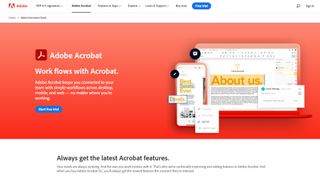Nuance Power PDF Advanced vs Adobe Acrobat
We compare Nuance Powder PDF Advanced versus Adobe Acrobat to see which comes out on top

Nuance's Power PDF is aimed directly at the market-leading Adobe Acrobat, but with a slant towards small office use. As such, it aims for a smoother workflow of documents for Internet use and archival.
Ease-of-use often comes down to familiarity with the interface. Where Adobe's designs have become the de-facto standard for graphics applications, for business tools Microsoft is the default. Since Office 2007, that default has used a ribbon, which is what Nuance's Power PDF adopts. The big advantage of the ribbon is the quick access to a large number of tools and options, without mining down through menus.

For example, to extract a page from a multipage PDF in Acrobat Pro XI, you need to show page thumbnails, right-click on the thumbnail of the section you want and select Extract pages from the menu. In Power PDF, Extract pages is on the Home ribbon; just click it.
Both of the programs include Optical Character Recognition (OCR), so both can be used to convert scans and image PDFs into searchable ones. Once searchable PDFs are available, both applications can also search them, but Power PDF includes 'Look Like Search', which can discover particular formats of text.
It offers pre-defined profiles for emails, dates and phone and credit card numbers, and it's possible to create your own patterns for specific text or numbers. It gives a lot more flexibility in finding information within a PDF.
Both applications can be used to annotate PDF documents with sticky notes, but Power PDF can do this from speech, as well as a keyboard. Using Dragon Notes, part of the stable of Nuance's speech recognition tools, you can quickly mark up documents for review or instruction. This is of most value to those who use speech recognition in other contexts, too.

Using a PDF creator for archival is a lot easier if you can automate the process. Both applications support batch processing and do it in much the same way, by offering a selection of operations, from which you build a custom list to complete the task you want to automate. Acrobat Pro XI still has the more comprehensive list of commands, including adding text, images and backgrounds, and applying encryption during a batch run.
Power PDF has a useful extra feature, though, where you can set up a Watch Folder. The application then monitors the named folder and automatically converts files to PDF – Normal or Searchable Image – and stores them in a second named folder. This is a useful set-and-forget feature, if you have a lot of regular archives to generate.
Document assembly is easy in both programs, with drag and drop creation, using thumbnails of the pages you want to add. Pages can be reordered in the same way and both PDF Portfolios and the earlier PDF packages are available. PDF and PDF/A are supported, with several levels of conformance.
Even with its advantages, Power PDF remains a lot cheaper than Adobe Acrobat XI. The standard version of Acrobat XI costs £279, while Power PDF Standard is £80 - more than 70 percent cheaper. Acrobat Pro comes in at £449, while Power PDF Advanced, costs more than 65 percent less, at £140.
Get the ITPro. daily newsletter
Receive our latest news, industry updates, featured resources and more. Sign up today to receive our FREE report on AI cyber crime & security - newly updated for 2024.




